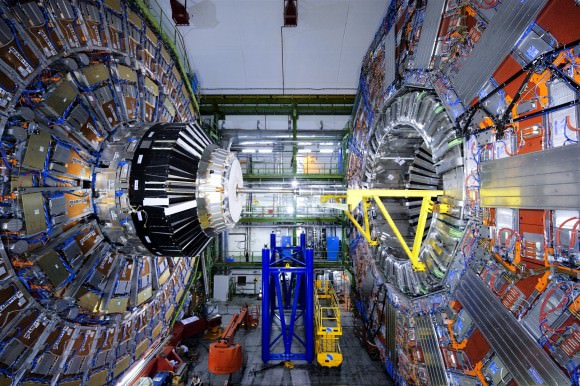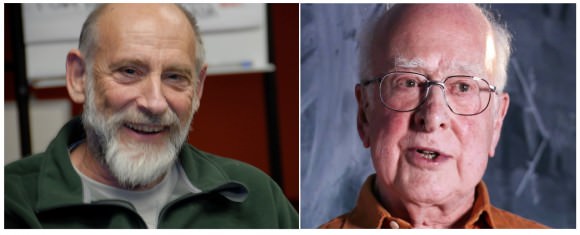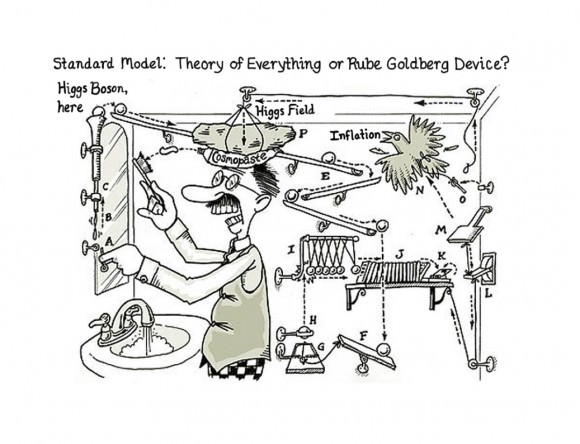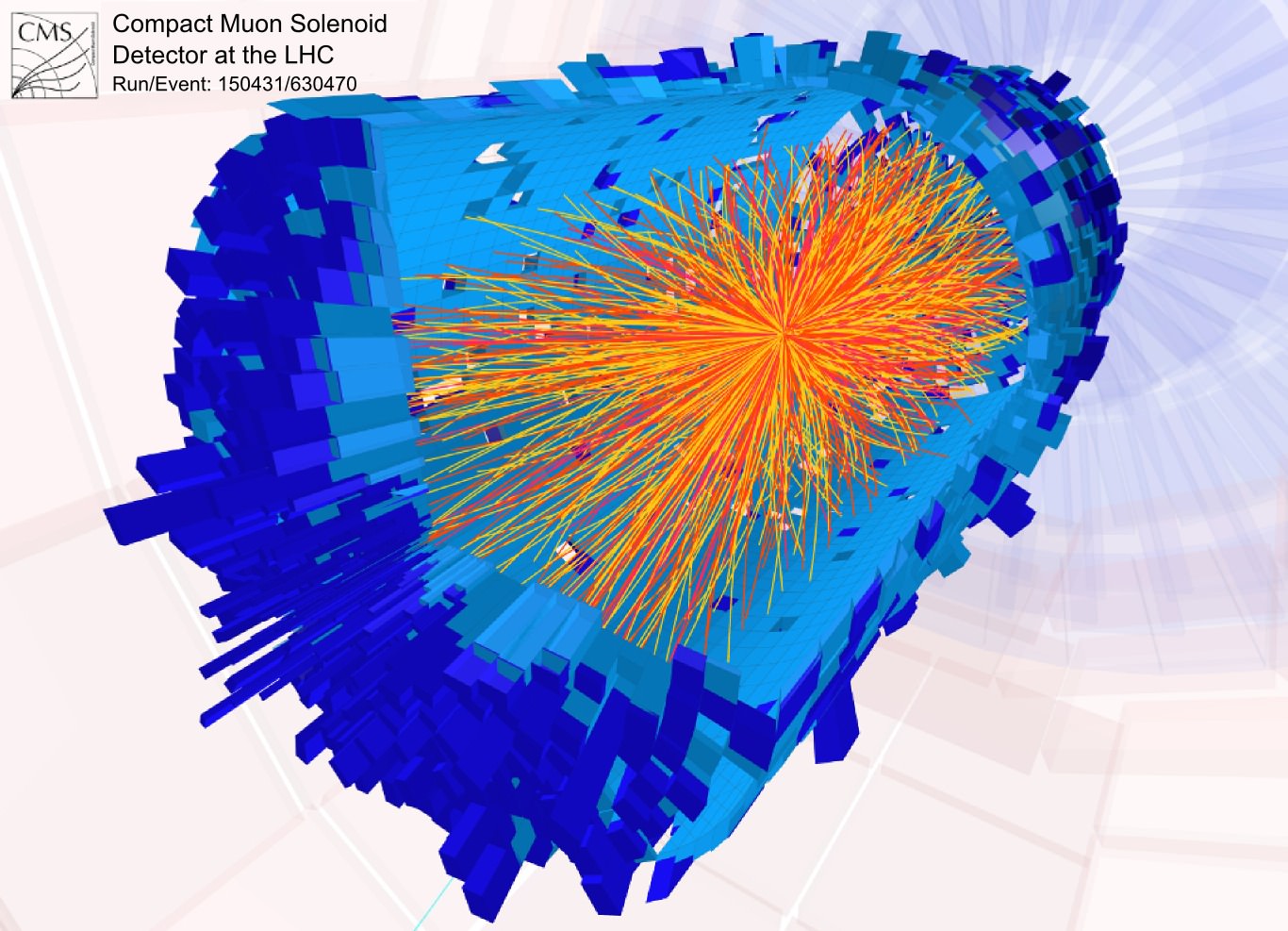At the Large Hadron Collider (LHC) in Europe, faster is better. Faster means more powerful particle collisions and looking deeper into the makeup of matter. However, other researchers are proclaiming not so fast. LHC may not have discovered the Higgs Boson, the boson that imparts mass to everything, the god particle as some have called it. While the Higgs Boson discovery in 2012 culminated with the awarding in December 2013 of the Nobel Prize to Peter Higgs and François Englert, a team of researchers has raised these doubts about the Higgs Boson in their paper published in the journal Physical Review D.
The discourse is similar to what unfolded in the last year with the detection of light from the beginning of time that signified the Inflation epoch of the Universe. Researchers looking into the depths of the Universe and the inner depths of subatomic particles are searching for signals at the edge of detectability, just above the noise level and in proximity to the signals from other sources. For the BICEP2 telescope observations (previous U.T. articles), its pretty much back to the drawing board but the Higgs Boson (previous U.T. articles) doubts are definitely challenging but needing more solid evidence. In human affairs, if the Higgs Boson was not detected by the LHC, what does one do with an awarded Nobel Prize?

The present challenge to the Higgs Boson is not new and is not just a problem of detectability and acuity of the sensors as is the case with BICEP2 data. The Planck space telescope revealed that light radiated from dust combined with the magnetic field in our Milky Way galaxy could explain the signal detected by BICEP2 that researchers proclaimed as the primordial signature of the Inflation period. The Higgs Boson particle is actually a prediction of the theory proposed by Peter Higgs and several others beginning in the early 1960s. It is a predicted particle from gauge theory developed by Higgs, Englert and others, at the heart of the Standard Model.
This recent paper is from a team of researchers from Denmark, Belgium and the United Kingdom led by Dr. Mads Toudal Frandsen. Their study entitled, “Technicolor Higgs boson in the light of LHC data” discusses how their supported theory predicts Technicolor quarks through a range of energies detectable at LHC and that one in particular is within the uncertainty level of the data point declared to be the Higgs Boson. There are variants of Technicolor Theory (TC) and the research paper compares in detail the field theory behind the Standard Model Higgs and the TC Higgs (their version of the Higgs boson). Their conclusion is that a TC Higgs is predicted by Technicolor Theory that is consistent with expected physical properties, is low mass and has an energy level – 125 GeV – indistinguishable from the resonance now considered to be the Standard Model Higgs. Theirs is a composite particle and it does not impart mass upon everything.
So you say – hold on! What is a Technicolor in jargon of particle physics? To answer this you would want to talk to a plumber from South Bronx, New York – Dr. Leonard Susskind. Though no longer a plumber, Susskind first proposed Technicolor to describe the breaking of symmetry in gauge theories that are part of the Standard Model. Susskind and other physicists from the 1970s considered it unsatisfactory that many arbitrary parameters were needed to complete the Gauge theory used in the Standard Model (involving the Higgs Scalar and Higgs Field). The parameters consequently defined the mass of elementary particles and other properties. These parameters were being assigned and not calculated and that was not acceptable to Susskind, ‘t Hooft, Veltmann and others. The solution involved the concept of Technicolor which provided a “natural” means of describing the breakdown of symmetry in the gauge theories that makeup the Standard Model.
Technicolor in particle physics shares one simple thing in common with Technicolor that dominated the early color film industry – the term composite in creating color or particles.

If the theory surrounding Technicolor is correct, then there should be many techni-quark and techni-Higgs particles to be found with the LHC or a more powerful next generation accelerator; a veritable zoo of particles besides just the Higgs Boson. The theory also means that these ‘elementary’ particles are composites of smaller particles and that another force of nature would be needed to bind them. And this new paper by Belyaev, Brown, Froadi and Frandsen claims that one specific techni-quark particle has a resonance (detection point) that is within the uncertainty of measurements for the Higgs Boson. In other words, the Higgs Boson might not be “the god particle” but rather a Technicolor Quark particle comprised of smaller more fundamental particles and another force binding them.
This paper by Belyaev, Brown, Froadi and Frandsen is a clear reminder that the Standard Model is unsettled and that even the discovery of the Higgs Boson is not 100% certain. In the last year, more sensitive sensors have been integrated into CERN’s LHC which will help refute this challenge to Higgs theory – Higgs Scalar and Field, the Higgs Boson or may reveal the signatures of Technicolor particles. Better detectors may resolve the difference between the energy level of the Technicolor quark and the Higgs Boson. LHC researchers were quick to state that their work moves on beyond discovery of the Higgs Boson. Also, their work could actually disprove that they found the Higgs Boson.
Contacting the co-investigator Dr. Alexander Belyaev, the question was raised – will the recent upgrades to CERN accelerator provide the precision needed to differentiate a technie-Quark from the Higg’s particle?
“There is no guarantee of course” Dr. Belyaev responded to Universe Today, “but upgrade of LHC will definitely provide much better potential to discover other particles associated with theory of Technicolor, such as heavy Techni-mesons or Techni-baryons.”
Resolving the doubts and choosing the right additions to the Standard Model does depend on better detectors, more observations and collisions at higher energies. Presently, the LHC is down to increase collision energies from 8 TeV to 13 TeV. Among the observations at the LHC, Super-symmetry has not fared well and the observations including the Higgs Boson discovery has supported the Standard Model. The weakness of the Standard Model of particle physics is that it does not explain the gravitational force of nature whereas Super-symmetry can. The theory of Technicolor maintains strong supporters as this latest paper shows and it leaves some doubt that the Higgs Boson was actually detected. Ultimately another more powerful next-generation particle accelerator may be needed.

For Higgs and Englert, the reversal of the discovery is by no means the ruination of a life’s work or would be the dismissal of a Nobel Prize. The theoretical work of the physicists have long been recognized by previous awards. The Standard Model as, at least, a partial solution of the theory of everything is like a jig-saw puzzle. Piece by piece is how it is being developed but not without missteps. Furthermore, the pieces added to the Standard Model can be like a house of cards and require replacing a larger solution with a wholly other one. This could be the case of Higgs and Technicolor.
At times like children somewhat determined, physicists thrust a solution into the unfolding puzzle that seems to fit but ultimately has to be retracted. The present discourse does not yet warrant a retraction. Elegance and simplicity is the ultimate characteristics sought in theoretical solutions. Particle physicists also use the term Naturalness when describing the concerns with gauge theory parameters. The solutions – the pieces – of the puzzle created by Peter Higgs and François Englert have spearheaded and encouraged further work which will achieve a sounder Standard Model but few if any claim that it will emerge as the theory of everything.
References:
Pre-print of Technicolor Higgs boson in the light of LHC data
An Introduction to Technicolor, P. Sikivie, CERN, October 1980


I’m sorry, but the Bicep2 results and the Higgs discovery were so very different from each other that comparing them in the headline strikes me as irresponsible. It comes across more as clickbait than as a helpful comparison.
With the Higgs, the announcement was only made after the discovery had been confirmed. Whether or not they found the exact thing they were looking for, it’s not in question that they found *something* new, and alternative explanations require new physics.
With Bicep2, there never was a discovery announcement. Instead, scientists basically said, “Our results are consistent with what you’d expect given theory X, and it needs to be confirmed, but isn’t this exciting?” And instead of positing any new physics, the criticisms involved explaining the results in terms of phenomena we already knew about (dust in the galaxy).
So … apples and oranges, in my opinion.
“In other words, the Higgs Boson might not be “the god particle” but rather a Technicolor Quark particle comprised of smaller more fundamental particles and another force binding them.” Funny you mentioned that cartoon which suggests the Standard Model is a RGM. Before I got down that far, I read the above quote and thought the same thing of the Technicolor Theory. Basically the discovery at CERN could be a simple marble dropping onto the ground or an uber complicated mess of a zoo of particles and another entire level to particle physics beyond the quarks…. AND another fundamental force: “Zany Zoo”, I suggest. Occam’s Razor, Ray Crock’s, K.eeep I.t S.imple S.tupid”… Logic, for Zod’s sake. 😉
Adrian. How the observations and data reductions were released are apples and oranges as you clearly say. The comparison I make is in regards to the slim margins that both have. In both cases, after the announcements, new data and a new theoretical assertion, respectively, have challenged the results. What TC claims is, as I described, similar to Bicep2 & Planck. Bicep2 researchers were confident that their line of sight had sufficiently low local source. Likewise, supporters of SM have had no need to be concerned that what they detected could be something else. This research paper is essentially stating that another source could explain the 125 GeV resonance. So, I’d maintain that it was a fair comparison. As for clickbait, I’d admit to taking advantage of this to attract readers to what I think is an intriguing story on a challenging topic to understand. But I do not think it was fallacious.
Tim — thanks for responding, and full credit to you for making your case thoughtfully.
The headline still makes me uncomfortable, because when people say “X is Y all over again”, it usually means that X shows that people haven’t learned the lesson they should have learned from Y. It implies that the same moral should be drawn from both experiences.
What moral might that be? Well, a number of people voiced the opinion (here’s an example) that the Bicep2 scientists should have waited before making a public announcement. So I think the natural assumption a reader would take from your headline is that the LHC scientists were likewise premature in announcing the discovery of the Higgs.
If you maintain that your choice of headline is defensible, I respect that, as long as I know you’ve reached that conclusion thoughtfully in the light of alternative viewpoints. Can’t ask for more than that. 🙂
I don’t think there’s any moral dimension or ‘should haves’ about announcing a finding. It’s always a risk. The self-correcting nature of science is going to catch up with you one way or the other.
IMHO the Bicep-2 people made a cautious murmur that was massively amplified by (largely) social media. You-tubing the surprise Andrei Linde champagne toast was probably inappropriate (i.e. I wonder if Linde really appreciated that).
However, CERN seemed to know exactly what they were doing and orchestrated their media release all the way along.
Anyhow, good job writing an attention-catching headline Tim 🙂